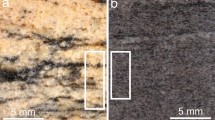Abstract
Chemical interaction between molten basalt and felsic minerals of the continental crust (quartz, K-feldspar, and oligoclase) was examined in static and dynamic experiments at 1,200°–1,400° C. Under circumstances of continuous stirring at 1,400°, β-quartz dissolves in tholeiite melt at a rate of 3.3×10−6 g/s per cm2 of contact area; at 1,300°, the solution rate is 1.5×10−6 g/cm{cm2}s. The feldspars are molten at the experimental conditions, and interact with contacting basalt melt by diffusion in the liquid state. This is a complex process characterized by rapid initial diffusion of alkalies to establish a distribution between felsic melt and basalt similar to that observed in cases of actual two-liquid equilibrium (both alkalies reach concentrations in the felsic melt 1.5–3 times those in the basalt). Alkali diffusion may be “uphill” or “downhill”, depending on which direction of net flux is required to produce a two-liquid type distribution. Once this distribution is attained, subsequent diffusion of all melt species is slow and apparently limited by the diffusivity of SiO2, which is 10−9-l0−10 cm2/s at 1,200° C. Interdiffusion experiments involving molten basalt and synthetic granite confirm the behavior illustrated by the feldspar/basalt results, and give similar SiO2 diffusivities.
The solution rates and interdiffusion data can be used to model basalt contamination processes likely to occur in the continental crust. For the restricted case of solid quartzitic xenoliths, the uptake of SiO2 in a well-mixed basalt magma is quite fast: appreciable SiO2 contamination may occur over exposure times of only days to years. If basalt magma induces local melting of crustal rocks, the assimilation process becomes one of liquid-state interdiffusion. In this case, the varying diffusivities of ions and their differing preferences for silicic relative to basaltic melts can produce marked selective contamination effects. Selective contamination of ascending basaltic magmas is particularly likely in the case of K2O, which may be introduced in substantial amounts even when other elements remain unaffected. The Na2O content of mantle-derived magmas is buffered against contamination by crustal materials, and K2O is buffered against further increases once it reaches a level of 1–1.5 wt.%.
Similar content being viewed by others
References
Al-Rawi Y, Carmichael ISE (1976) A note on the natural fusion of granite. Am Mineral 52:1806–1814
Bogoyavlenskaya G (1972) Melted xenoliths of intrusive rocks in the pyroclastic deposits of the Uzon and Semyatchinskaya ring structures (Kamchatka). Bull Volcanol 36:443–445
Bowen NL (1928) The evolution of the igneous rocks. Princeton University Press (reprinted by Dover Press, 1956)
Carlson RW, Lugmair GW, Macdougall JD (1981) Columbia River volcanism: the question of mantle heterogeneity or crustal contamination. Geochim Cosmochim Acta 45:2483–2499
Carmichael ISE, Turner FJ, Verhoogen J (1974) Igneous petrology. McGraw-Hill, 739 pp
Carter SR, Evensen NM, Hamilton PJ, O'nions RK (1978) Neodymium and strontium isotope evidence for crustal contamination of continental volcanics. Science 202:743–747
Crank J (1975) The mathematics of diffusion. Second edition. Oxford University Press
DePaolo DJ (1981) Trace element and isotopic effects of combined wallrock assimilation and fractional crystallization. Earth Planet Sci Eett 53:189–202
Doe BR, Lipman PW, Hedge CE, Kurasawa H (1969) Primitive and contaminated basalts from the southern Rocky Mountains, USA. Contrib Mineral Petrol 21:142–156
Hess PC, Rutherford MJ (1974) Element fractionation between immiscible melts (abstr). Lunar Science V:328–329
Hildreth W (1976) The Bishop tuff: compositional zonation in a silicic magma chamber without crystal settling. Geol Soc Am Abstr with Progr 8:918
Hildreth W (1981) Gradients in silicic magma chambers: implications for lithospheric magmatism. J Geophys Res 86:10153–10192
Hofmann AW (1980) Diffusion in natural silicate melts: A critical review. In: RB Hargraves ed, Physics of magmatic processes pp 385–417. Princeton University Press, 585 pp
Hofmann AW, Brown L (1976) Diffusion measurements using fast deuterons for in situ production of radioactive tracers. Carnegie Inst Washington Yearb 75:259–262
Holmes A (1936) Transfusion of quartz xenoliths in alkali basic and ultrabasic lavas, south-west Uganda. Mineral Mag 24:408–421
Kays MA, McBirney AR, Goles GG (1981) Xenoliths of gneisses and the conformable, clot-like granophyres in the marginal border group, Skaergaard intrusion, East Greenland. Contrib Mineral Petrol 76:265–284
Mahood GA (1981) A summary of the geology and petrology of the Sierra La Primavera, Jalisco, Mexico. J Geophys Res 86:10137–10152
Marsh BD (1978) On the cooling of ascending andesitic magma. Philos Trans R Soc London A 288:611–625
Maury RC, Bizouard H (1974) Melting of acid xenoliths into a basanite: an approach to the possible mechanisms of crustal contamination. Contrib Mineral Petrol 48:275–286
McBirney AR (1979) Effects of assimilation. In: HS Yoder Jr (ed) The evolution of the igneous rocks, Fifthieth Anniversary Perspectives, pp 307–338. Princeton University Press, 588 pp
Naslund HR (1982) An experimental study of liquid immiscibility in iron-bearing silicate melts. Am J Sci (in press)
Moorbath S, Bell JD (1965) Strontium isotope abundance studies and rubidium-strontium age determinations on Tertiary igneous rocks from the Isle of Skye, northwest Scotland. J Petrol 6:37–66
Pankhurst RJ (1969) Strontium isotope studies related to petrogenesis in the Caledonian basic igneous province of NE Scotland. J Petrol 10:115–143
Ryerson FJ, Hess PC (1978) Implications of liquid-liquid distribution coefficients to mineral-liquid partitioning. Geochim Cosmochim Acta 42:921–932
Sato H (1974) Diffusion coronas around quartz xenocrysts in andesite and basalt from Tertiary volcanic region in northeastern Shikoku, Japan. Contrib Mineral Petrol 50:49–64
Shaw HR (1980) The fracture mechanisms of magma transport from the mantle to the surface. In: Physics of magmatic processes pp 201–264. Princeton University Press, 585 pp
Shewmon PG (1963) Diffusion in solids. McGraw-Hill, 203 pp
Sigurdsson H (1968) Petrology of acid xenoliths from Surtsey. Geol Mag 105:440–453
Smith HD (1974) An experimental study of the diffusion of Na, K, and Rb in magmatic silicate liquids. Ph D dissertation, University of Oregon
Taylor HP Jr (1980) The effects of assimilation of country rocks by magmas on 18O/16O and 87Sr/86Sr systematics in igneous rocks. Earth Planet Sci Lett 47:243–254
Watson EB (1976) Two-liquid partition coefficients: experimental data and geochemical implications. Contrib Mineral Petrol 56:119–134
Watson EB (1981) Diffusion in magmas at depth in the earth: the effects of pressure and dissolved H2O. Earth Planet Sci Lett 52:291–301
Wyllie PJ (1961) Fusion of Torridonian sandstone by a picritic sill in Soay (Hebrides). J Petrol 2:1–37
Yoder HS Jr (1973) Contemporaneous basaltic and rhyolitic magmas. Am Mineral 58:153–171
Zindler A, Hart SR, Brooks C (1981) The Shabogamo intrusive suite, Labrador: Sr and Nd isotopic evidence for contamination of mafic magmas in the Proterozoic. Earth Planet Sci Lett 54:217–235
Author information
Authors and Affiliations
Rights and permissions
About this article
Cite this article
Watson, E.B. Basalt contamination by continental crust: Some experiments and models. Contr. Mineral. and Petrol. 80, 73–87 (1982). https://doi.org/10.1007/BF00376736
Received:
Accepted:
Issue Date:
DOI: https://doi.org/10.1007/BF00376736




